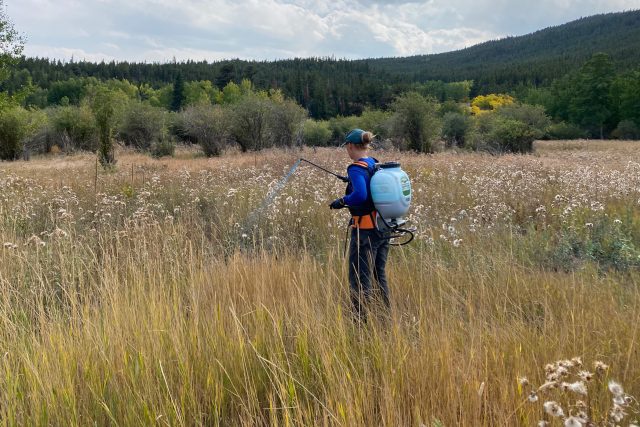
Whether you consider weed management titillating or not, the control of noxious weeds has been a point of tension in Boulder County for decades, particularly the use of herbicides and, more recently, helicopters to perform aerial sprays.
Earlier this month, the County released the first draft of a new integrated weed management plan to guide its policies for more than 50,000 acres of the nearly 115,000 Boulder County Parks and Open Space is tasked with overseeing.
Following the new plan is a public engagement period featuring surveys, tours and Parks and Open Space Advisory Committee (POSAC) meetings until the Boulder County Commissioner’s final vote on Feb. 15. The last time the County’s weed management plan went through a similar public process was in 2004.
“Our goal with the integrated weed management plan is to have a healthy ecosystem, and protect the health and safety of the people who live, work and recreate in Boulder County,” says Therese Glowacki, director of Boulder County Parks and Open Space.
But Mark Guttridge, founder of Ollin Farms, was “pretty disturbed” to see the plan include aerial spray options via drone and helicopter, and continued herbicide use.
“I’d like to see really no herbicide use at all,” he says, “but I know that we have to find a middle ground and I’m trying to do everything we can to provide alternatives for Open Space to really meet us halfway.”
Ollin Farms uses regenerative agriculture principles to “produce top-quality farm products while continuing to increase the diversity and health of ecosystems around us,” and doesn’t use pesticides or herbicides. Guttenridge is concerned that spraying herbicides, especially aerially, could have unintended consequences.
“None of [the County’s herbicides] pass the test of, ‘We should be spraying this from the fricken air,’” he says. “The herbicides should only be hitting the exact plant you need to hit at that time.”
The County has used Milestone, Hardball, Telar, Quinstar and Method herbicides in the last month, according to the county’s website, but it paused aerial herbicide applications earlier this year until the integrated weed management plan is updated and a decision on whether to resume aerial applications is made. The last time aerial spray was used by Boulder County was on Nov. 1, 2022 via helicopter at Hall Ranch, which faced scrutiny from some community members.
Glowacki says the County “rarely” uses broadcast spray methods, which include backpack sprayers and truck, tractor, helicopter and drone applications.
The new plan says “broadcast spraying is often the most effective and cost-effective method to control large noxious weed infestations because of size, type of infestation and nature of topography.”
Earlier this year, the County used 2,4-D to treat curly dock at Heil Valley Ranch. The Natural Resources Defense Council says a growing body of research indicates 2,4-D “poses a danger to both human health and the environment.” The method of application on the County’s website isn’t clear.
The drafted weed management plan combines the previous two plans — one for Parks and Open Space and the other for the overall county — and includes decision processes and strategies to minimize noxious weed problems.
The document outlines the use of a variety of tools, including cultural, mechanical and biological control. When it comes to chemicals, Glowacki says the County uses “the lowest toxicity herbicides in the smallest amounts to be effective at controlling weeds” and wants to “keep all of those tools in the toolbox.”
The budget for herbicide use, including aerial spraying, will be presented at the Dec. 5 POSAC meeting.
While Glowacki says the County takes careful considerations when applying herbicides by following product labels to not impact water or air quality, Guttenridge isn’t sure that matters.
“They’ll give directions on labels like how to do it and recommended setbacks [from waterways], but on the very same level that’s telling you this stuff is toxic,” he says.
A survey asking the public for feedback on the plan closed on Oct. 18, but there are multiple opportunities for residents to attend POSAC or other public meetings to provide comments on the drafted plan before the commissioners’ final vote.
POSAC regular meeting
6:30 p.m. Thursday, Oct. 26, Boulder County Courthouse, 1325 Pearl St. Registration is required for those who want to comment: bit.ly/_POSAC_registration
By the numbers
The County treats nearly 50,000 acres for noxious weed. Below is a breakdown of management acres by treatment method so far in 2023.
Mowing: 1,215 acres
Manual (hand-pulling): 4,447 acres
Total herbicide spot application: 1,980 acres *
Total herbicide broadcast application: 300 acres *
The County hasn’t completed any aerial applications this year.
* Noxious weeds often do not make up the entirety of a treatment area, meaning the actual number of acres treated is lower than the total application acres (spot application: 123; broadcast application: 73.5).














